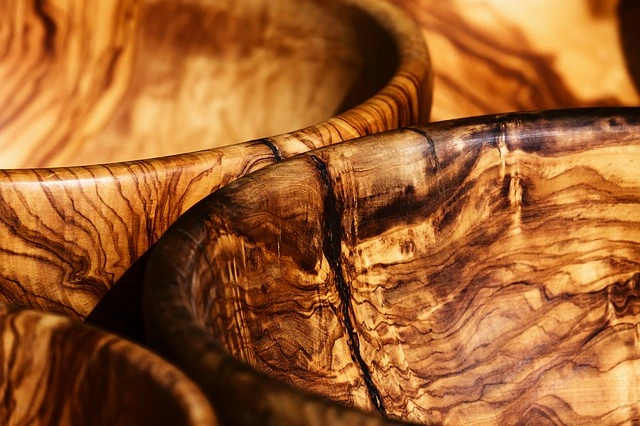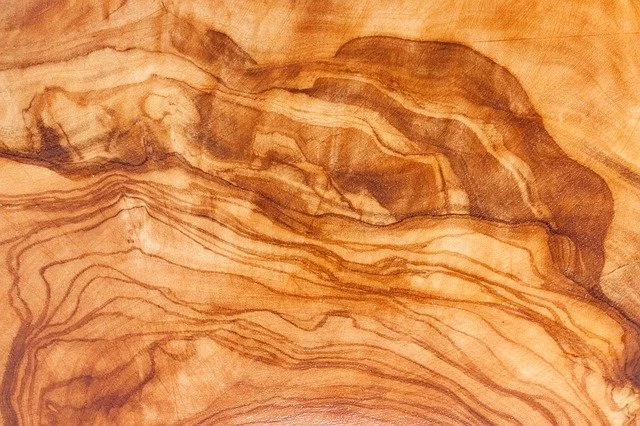Olive wood is an exotic wood that originated in Europe, Africa, and the Middle East. It is a hardwood that is sturdy and durable. It has several characteristics that make it great for woodturning and carving.
This hardwood is unique in that it has a beautiful grain pattern and an inviting fragrance. It becomes darker, richer, and more beautiful in color as it ages. That makes it an ideal wood type for artistic artifacts. It finishes with a high degree of polish.

Olive wood has a beautiful, rich, and colorful appearance, making it perfect for decorative objects. It has structural features that contrast brown lines and yellow streaks of sapwood.
The surface of olive is easy to polish to a high degree. It is a bit uncooperating during the cutting process, but easy to glue. It also produces a distinct, pleasant, and sweet odor that remains present in the finished product for several years.
Olive comes with its limitations. It lacks natural oils that repel insects and rot. Furniture made from olive wood needs treatment to preserve it when exposed to natural elements. Raw olive wood is hard to dry, and the lumber may start to warp during this process. It needs to be Kiln-dried at low heat levels.
Types of olive wood
Olea europaea
The Olea europaea is a traditional olive tree. It is native to the eastern Mediterranean, Syria, Asia Minor, the Southern end of the Caspian Sea, and northern Iran. What separates it from the rest of the wood is its versatility. Its branches are a symbol of peace.
Olea capensis
It is an African tree of the Olive family, known as black ironwood. It grows across Sub-Saharan Africa and has three subspecies (macrocarpa, capensis, and enervis).
Is olive wood good for carving

Olive wood is easier to carve than other woods. You do not need special carving tools for accuracy when carving the wood. Make use of simple hand tools. It comes with a diverse variety of natural colors and tonal depth due to the annual structure. It is friendly to turn and carve.
Olive wood is resistant to decay and receptive to surface treatments. It is popular for manufacturing artistic, religious, and historical works. These include cups, crosses, magnets, kitchen utensils, ornaments, flower vases, and wall decorations.
Is olive wood good for whittling?
Yes, Olivewood is hard to get but good for whittling. If you get it, it makes some beautiful items such as book covers, picture frames, boxes, ornaments, and crosses. It can be challenging due to the wood’s hardness and interlocking, irregular grain.
How hard is olive wood?
The Janka hardness rating of olive wood is 1520 pounds of force, indicating its resistance to denting and wear. Olive wood has a straight grain with a fine texture and is known for its hardness, strength, and high density.
Why is olive wood so expensive?
Olive wood is less affordable because of its durability. It comes with the wood’s fine texture, combined with its natural waxy feel. That makes it ideal for turning and carving. The wood is rare to find hence the steep price. It makes kitchen utensils, bowls, cutting boards, and decorative turned objects.
Is olive wood hard to carve?
Olive wood can be challenging to carve due to its hardness, which makes it resistant to cutting and shaping. However, it is still possible to carve olive wood with regular carving tools, although it may require more effort and time than other wood types.
How to carve olive wood
- Soak the wood in denatured alcohol for about a week.
- Re-dry out slowly to prevent cracking or checking.
- Carve olive wood in an abstract form.
- Carve details such as the face and body.
- Smoothen the body with sandpaper, getting rid of tough surfaces and edges.
- Protect the wood and make it shiny with any lacquer of your choice.
Things to carve out of olive wood
It makes rosaries, jewelry, tableware, desk ware, nativity sets, figurines, ornaments, kitchenware, and plaques.
Treating olive wood
Treat olive wood by rubbing in a little food-safe mineral oil, or any other food-grade oil. Use coconut, olive, sunflower oil, etc. Rub a small amount of oil onto the wood using a kitchen towel or lint-free cloth.
How to preserve olive wood
Season new utensils with food-safe mineral oil.
You buy olive wood from the shop, already seasoned and ready to use. Keep applying mineral oil, especially during the first weeks. That ensures a well-moisturized and protected bowl, board, or utensil.
Hand washes with mild detergent and warm water.
Clean olive wood kitchen tools and utensils, not using standing water. Standing water weakens the wood fibers and leads to splitting and cracking.
Dry with a lint-free cloth or microfiber. Let the air dry, and condition with mineral oil or Bowl and Board Rub more often.
Clean your Woodenware when needed with a scrub of lemon juice and salt. If you have not used a wooden bowl or utensil, sanitize with 3 per cent hydrogen peroxide mixed with equal water.
Where can I buy olive wood for carving?
You can buy olive wood from Amazon, Etsy, Alibaba, and workshop heaven.
How to dry olive wood
- Put a thin wax coating on the faces and then wrap the piece on paper.
- Put it in a cool, damp location for a year.
- Check the core MC to see if it is under 30% MC so you can bring it out and dry it the standard way.
Cost of olive wood
Olive is less affordable. Prices start at about 35/ bf; high-end olive wood costs as much as 140/bf.
Is Russian olive wood toxic?
No further health reactions are with Russian Olive besides the standard health risks associated with any wood dust.
Can you burn Russian olive wood?
Russian olive wood produces an unpleasant odor when green and does not burn. It produces excess smoke. You cannot burn it until it has seasoned for at least one year.
- Grain and Sheen: Teak Oil versus Danish Oil Uncovered - January 10, 2024
- The Cherry on Top: Crafting the Perfect Cutting Board - January 9, 2024
- Polyurethane Water-Based vs Oil-Based: Choosing the Right Finish - January 8, 2024
